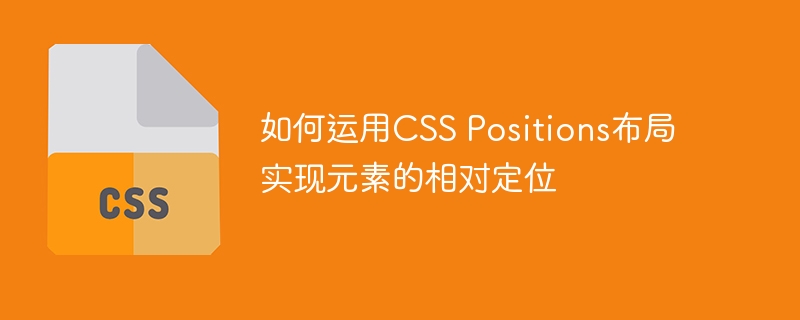

How to use CSS Positions layout to achieve relative positioning of elements requires specific code examples
In web design, we often need to position elements to achieve what we want The desired layout effect. CSS provides a variety of position attributes, among which relative positioning (relative) is a commonly used method. This article will introduce how to use CSS relative positioning to achieve relative positioning of elements, and provide specific code examples.
1. The basic concept of relative positioning
Relative positioning refers to positioning relative to the position of the element itself in the normal document flow. Relatively positioned elements still occupy their position in the document flow, but are offset from their original positions. We can control the relative offset position of elements by setting attributes such as top, right, bottom, and left. A relatively positioned element is positioned relative to its original position, not other elements.
2. How to use the relative positioning of CSS
To realize the relative positioning of elements, we can follow the following steps:
.element {
position: relative;
}.element {
position: relative;
top: 10px;
left: 20px;
}By setting top to 10px and left to 20px, the element will be offset vertically by 10px down and horizontally by 20px to the right.
3. Specific code example
Below we use a specific code example to demonstrate how to use CSS relative positioning to position elements.
HTML code:
<!DOCTYPE html> <html> <head> <title>相对定位示例</title> <link rel="stylesheet" type="text/css" href="styles.css"> </head> <body> <div class="container"> <div class="box1"></div> <div class="box2"></div> </div> </body> </html>
CSS code:
.container {
width: 300px;
height: 300px;
position: relative;
}
.box1 {
width: 100px;
height: 100px;
background-color: red;
position: relative;
top: 20px;
left: 30px;
}
.box2 {
width: 100px;
height: 100px;
background-color: blue;
position: relative;
top: 50px;
left: 100px;
}In the above code, we create a container with a width of 300px and a height of 300px, which contains two Elements box1 and box2. The top and left sides of box1 are offset by 20px and 30px respectively, while the top and left sides of box2 are offset by 50px and 100px respectively.
Through the above code example, we can see that relative positioning can achieve relative offset of elements, thereby achieving the layout effect we require. This relative positioning method is very useful when designing responsive layouts and element cascading effects.
Summary:
This article introduces how to use the relative positioning of CSS to achieve relative positioning of elements, and provides specific code examples. By setting the position attribute to relative and setting the top, right, bottom, and left properties, we can easily control the offset of the element relative to its original position. Relative positioning is a commonly used layout method that can help us achieve various complex layout effects in web pages.
The above is the detailed content of How to use CSS Positions layout to achieve relative positioning of elements. For more information, please follow other related articles on the PHP Chinese website!